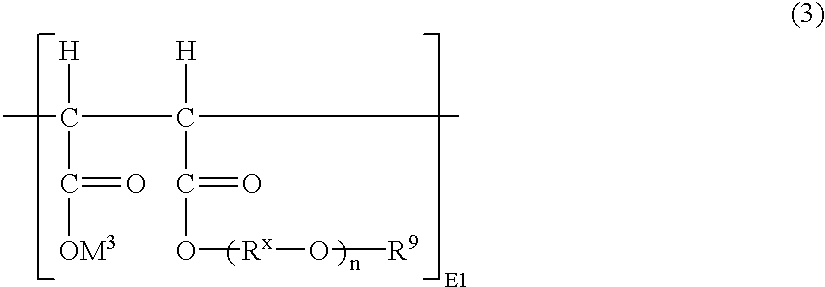Cement additive, cement composition and polycarboxylic acid polymer
a technology of cement additive which is applied in the field of cement additive, cement composition and polycarboxylic acid polymer, can solve the problems of inability to obtain sufficient dispersibility, inability to achieve sufficient dispersibility, and poor ability of said compound to be adsorbed on cement particles, etc., and achieve excellent dispersibility
- Summary
- Abstract
- Description
- Claims
- Application Information
AI Technical Summary
Benefits of technology
Problems solved by technology
Method used
Image
Examples
synthesis examples 1 to 5
A glass reaction vessel equipped with thermometer, stirrer, dropping funnel, nitrogen inlet tube and reflux condenser was charged with the specified amount (see Table 1) of the specified ethyl vinyl ether-maleic anhydride copolymer species (see Table 1) and 20 g of dehydrated tetrahydrofuran to effect dissolution of the ethyl vinyl ether-maleic anhydride copolymer. Then, a methoxypolyethylene glycol alkoxide solution (Synthesis Example 1, 2, 3 or 5) or a butoxypolypropylene glycol alkoxide solution (Synthesis Example 4) separately prepared by adding the specified amount (see Table 1) of sodium hydride to a solution of the specified amount (see Table 1) of the specified polyalkylene glycol species (see Table 1) in 20 g of tetrahydrofuran was added dropwise to the reactor at room temperature. After completion of the dropping, the reaction was allowed to proceed for 24 hours while maintaining the reaction temperature at 55.degree. C. Thereafter, the tetrahydrofuran was distilled off us...
example 1
Taiheiyo ordinary portland cement (product of Taiheiyo Cement; 600 g) and 600 g of Toyoura standard sand were dry-mixed in a mortar mixer (trademark: N-50; product of Tesco) at a low speed of revolution for 30 seconds. Then, 210 g of water with each polycarboxylic acid polymer specified in Table 2 incorporated therein was added to the dry mixed cement-sand mixture and the whole mixture was kneaded at a high speed of revolution for 3 minutes. In this manner, each of mortars (1) to (15) was prepared. The polycarboxylic acid polymer was incorporated in an amount such that the weight percentage of the solid relative to the cement weight amounted to the respective value given in Table 2. In preparing the mortars, care was taken so that the dry mixing and kneading conditions in the mortar mixer might remain identical.
The mortars (1) to (15) obtained were evaluated by the methods shown below. The results are shown in Table 2.
Evaluation Methods
(1) Mortar Homogenization Time
Water (210 g) wit...
synthesis examples 6 to 9
The same glass reaction vessel as used in Synthesis Examples 1 to 5 was charged with the amount specified in Table 4 of the styrene-maleic anhydride copolymer specified in Table 4 and 20 g of dehydrated tetrahydrofuran to effect dissolution of said polymer. Then, a methoxypolyethylene glycol alkoxide solution separately prepared by adding 0.04 g of sodium hydride to a solution of the amount specified in Table 4 of the polyalkylene glycol specified in Table 4 in 20 g of dehydrated tetrahydrofuran was added dropwise into the reactor at room temperature. After completion of the dropping, the reaction was allowed to proceed for 24 hours while maintaining the reaction temperature at 55.degree. C. Thereafter, the reaction mixture was treated in the same manner as in Synthesis Examples 1 to 5. This procedure gave polycarboxylic acid polymers (6) to (9). The values of n, m, na, S1, T1, E1 and E2 for each of the polymers obtained and the weight average molecular weight (Mw) thereof are shown...
PUM
| Property | Measurement | Unit |
|---|---|---|
| Fraction | aaaaa | aaaaa |
| Fraction | aaaaa | aaaaa |
| Fraction | aaaaa | aaaaa |
Abstract
Description
Claims
Application Information
 Login to View More
Login to View More - R&D
- Intellectual Property
- Life Sciences
- Materials
- Tech Scout
- Unparalleled Data Quality
- Higher Quality Content
- 60% Fewer Hallucinations
Browse by: Latest US Patents, China's latest patents, Technical Efficacy Thesaurus, Application Domain, Technology Topic, Popular Technical Reports.
© 2025 PatSnap. All rights reserved.Legal|Privacy policy|Modern Slavery Act Transparency Statement|Sitemap|About US| Contact US: help@patsnap.com



